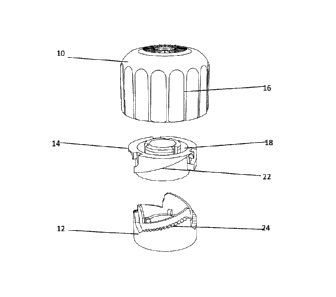Some of the information on this Web page has been provided by external sources. The Government of Canada is not responsible for the accuracy, reliability or currency of the information supplied by external sources. Users wishing to rely upon this information should consult directly with the source of the information. Content provided by external sources is not subject to official languages, privacy and accessibility requirements.
Any discrepancies in the text and image of the Claims and Abstract are due to differing posting times. Text of the Claims and Abstract are posted:
| (12) Patent: | (11) CA 2827667 |
|---|---|
| (54) English Title: | FURNITURE LEVELLING DEVICE |
| (54) French Title: | DISPOSITIF DE REGLAGE DE NIVEAU POUR MEUBLES |
| Status: | Deemed expired |
| (51) International Patent Classification (IPC): |
|
|---|---|
| (72) Inventors : |
|
| (73) Owners : |
|
| (71) Applicants : |
|
| (74) Agent: | MOFFAT & CO. |
| (74) Associate agent: | |
| (45) Issued: | 2018-11-20 |
| (86) PCT Filing Date: | 2012-02-16 |
| (87) Open to Public Inspection: | 2012-08-23 |
| Examination requested: | 2017-02-08 |
| Availability of licence: | N/A |
| (25) Language of filing: | English |
| Patent Cooperation Treaty (PCT): | Yes |
|---|---|
| (86) PCT Filing Number: | PCT/ZA2012/000008 |
| (87) International Publication Number: | WO2012/112996 |
| (85) National Entry: | 2013-08-16 |
| (30) Application Priority Data: | ||||||
|---|---|---|---|---|---|---|
|
The invention provides a device for adjusting the effective length of a table
leg. The device
includes an upper and a lower member (10, 12, 14) that is rotatably associated
with one
another and are biased apart by spring means (20), the upper member (14)
including a first
downwardly directed ramp (22) spaced apart from a second ratchet ramps (24)
associated
with the lower member (12) by a wall. The upper member (10) includes one or
more pawls
(25) adapted to run in the channel between the ramps (22, 24), and including a
formation
adapted to engage the ratchet when the desired effective length of the leg
plus device has
been adjusted.
L'invention concerne un dispositif destiné à régler la longueur utile d'un pied de table. Le dispositif comprend des éléments supérieur et inférieur (10, 12, 14) associés l'un à l'autre de façon tournante et sont sollicités dans le sens de l'écartement par des moyens élastiques (20), l'élément supérieur (14) comprenant une première rampe descendante (22) espacée par rapport à une deuxième rampe à rochet (24) associée à l'élément inférieur (12) par une paroi. L'élément supérieur (10) comprend un ou plusieurs cliquets (25) conçus pour circuler dans la rainure entre les rampes (22, 24), et comprenant une formation conçue pour coopérer avec le rochet lorsque la longueur utile souhaitée du pied et du dispositif combinée a été réglée.
Note: Claims are shown in the official language in which they were submitted.
Note: Descriptions are shown in the official language in which they were submitted.

For a clearer understanding of the status of the application/patent presented on this page, the site Disclaimer , as well as the definitions for Patent , Administrative Status , Maintenance Fee and Payment History should be consulted.
| Title | Date |
|---|---|
| Forecasted Issue Date | 2018-11-20 |
| (86) PCT Filing Date | 2012-02-16 |
| (87) PCT Publication Date | 2012-08-23 |
| (85) National Entry | 2013-08-16 |
| Examination Requested | 2017-02-08 |
| (45) Issued | 2018-11-20 |
| Deemed Expired | 2020-02-17 |
There is no abandonment history.
| Fee Type | Anniversary Year | Due Date | Amount Paid | Paid Date |
|---|---|---|---|---|
| Application Fee | $200.00 | 2013-08-16 | ||
| Maintenance Fee - Application - New Act | 2 | 2014-02-17 | $50.00 | 2014-02-14 |
| Maintenance Fee - Application - New Act | 3 | 2015-02-16 | $50.00 | 2015-01-19 |
| Maintenance Fee - Application - New Act | 4 | 2016-02-16 | $50.00 | 2016-02-15 |
| Maintenance Fee - Application - New Act | 5 | 2017-02-16 | $100.00 | 2017-02-01 |
| Request for Examination | $400.00 | 2017-02-08 | ||
| Maintenance Fee - Application - New Act | 6 | 2018-02-16 | $100.00 | 2018-02-14 |
| Final Fee | $150.00 | 2018-10-05 | ||
| Maintenance Fee - Patent - New Act | 7 | 2019-02-18 | $100.00 | 2019-02-11 |
Note: Records showing the ownership history in alphabetical order.
| Current Owners on Record |
|---|
| GILD, KEITH |
| Past Owners on Record |
|---|
| None |